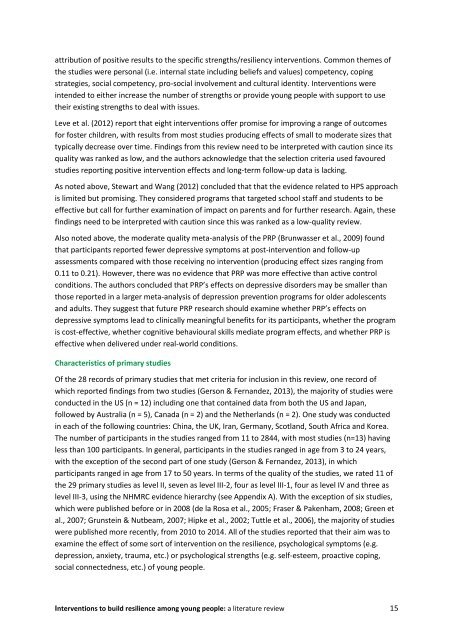Interventions to build resilience among young people A literature review
Interventions-to-build-resilience-among-young-people
Interventions-to-build-resilience-among-young-people
You also want an ePaper? Increase the reach of your titles
YUMPU automatically turns print PDFs into web optimized ePapers that Google loves.
attribution of positive results <strong>to</strong> the specific strengths/resiliency interventions. Common themes of<br />
the studies were personal (i.e. internal state including beliefs and values) competency, coping<br />
strategies, social competency, pro-social involvement and cultural identity. <strong>Interventions</strong> were<br />
intended <strong>to</strong> either increase the number of strengths or provide <strong>young</strong> <strong>people</strong> with support <strong>to</strong> use<br />
their existing strengths <strong>to</strong> deal with issues.<br />
Leve et al. (2012) report that eight interventions offer promise for improving a range of outcomes<br />
for foster children, with results from most studies producing effects of small <strong>to</strong> moderate sizes that<br />
typically decrease over time. Findings from this <strong>review</strong> need <strong>to</strong> be interpreted with caution since its<br />
quality was ranked as low, and the authors acknowledge that the selection criteria used favoured<br />
studies reporting positive intervention effects and long-term follow-up data is lacking.<br />
As noted above, Stewart and Wang (2012) concluded that that the evidence related <strong>to</strong> HPS approach<br />
is limited but promising. They considered programs that targeted school staff and students <strong>to</strong> be<br />
effective but call for further examination of impact on parents and for further research. Again, these<br />
findings need <strong>to</strong> be interpreted with caution since this was ranked as a low-quality <strong>review</strong>.<br />
Also noted above, the moderate quality meta-analysis of the PRP (Brunwasser et al., 2009) found<br />
that participants reported fewer depressive symp<strong>to</strong>ms at post-intervention and follow-up<br />
assessments compared with those receiving no intervention (producing effect sizes ranging from<br />
0.11 <strong>to</strong> 0.21). However, there was no evidence that PRP was more effective than active control<br />
conditions. The authors concluded that PRP’s effects on depressive disorders may be smaller than<br />
those reported in a larger meta-analysis of depression prevention programs for older adolescents<br />
and adults. They suggest that future PRP research should examine whether PRP’s effects on<br />
depressive symp<strong>to</strong>ms lead <strong>to</strong> clinically meaningful benefits for its participants, whether the program<br />
is cost-effective, whether cognitive behavioural skills mediate program effects, and whether PRP is<br />
effective when delivered under real-world conditions.<br />
Characteristics of primary studies<br />
Of the 28 records of primary studies that met criteria for inclusion in this <strong>review</strong>, one record of<br />
which reported findings from two studies (Gerson & Fernandez, 2013), the majority of studies were<br />
conducted in the US (n = 12) including one that contained data from both the US and Japan,<br />
followed by Australia (n = 5), Canada (n = 2) and the Netherlands (n = 2). One study was conducted<br />
in each of the following countries: China, the UK, Iran, Germany, Scotland, South Africa and Korea.<br />
The number of participants in the studies ranged from 11 <strong>to</strong> 2844, with most studies (n=13) having<br />
less than 100 participants. In general, participants in the studies ranged in age from 3 <strong>to</strong> 24 years,<br />
with the exception of the second part of one study (Gerson & Fernandez, 2013), in which<br />
participants ranged in age from 17 <strong>to</strong> 50 years. In terms of the quality of the studies, we rated 11 of<br />
the 29 primary studies as level II, seven as level III-2, four as level III-1, four as level IV and three as<br />
level III-3, using the NHMRC evidence hierarchy (see Appendix A). With the exception of six studies,<br />
which were published before or in 2008 (de la Rosa et al., 2005; Fraser & Pakenham, 2008; Green et<br />
al., 2007; Grunstein & Nutbeam, 2007; Hipke et al., 2002; Tuttle et al., 2006), the majority of studies<br />
were published more recently, from 2010 <strong>to</strong> 2014. All of the studies reported that their aim was <strong>to</strong><br />
examine the effect of some sort of intervention on the <strong>resilience</strong>, psychological symp<strong>to</strong>ms (e.g.<br />
depression, anxiety, trauma, etc.) or psychological strengths (e.g. self-esteem, proactive coping,<br />
social connectedness, etc.) of <strong>young</strong> <strong>people</strong>.<br />
<strong>Interventions</strong> <strong>to</strong> <strong>build</strong> <strong>resilience</strong> <strong>among</strong> <strong>young</strong> <strong>people</strong>: a <strong>literature</strong> <strong>review</strong> 15


